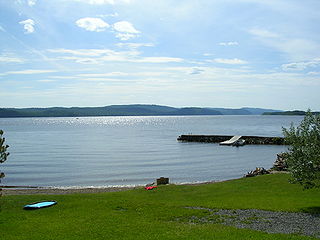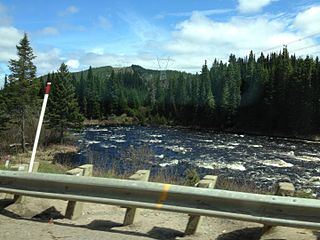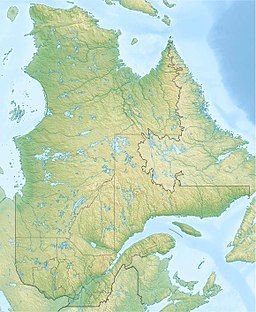
Kenogami lake is a long lake in the Saguenay–Lac-Saint-Jean region of south-central Quebec, Canada. Situated at an altitude of 150 m (490 ft), the lake is 27 km (17 mi) long and 11 to 102 m deep. "Kénogami" means "long lake" in the Montagnais dialect and was originally used to refer to Kenogami Lake, Ontario.
The Rivière à Mars Nord-Ouest is a tributary of the rivière à Mars flowing in the unorganized territory of Lac-Pikauba, in the Charlevoix Regional County Municipality, in the administrative region of Capitale-Nationale, in the province of Quebec, Canada. The "rivière à Mars North-West" crosses the central-western part of the Laurentides Wildlife Reserve.
The Bras de Jacob Ouest is a tributary of the Bras de Jacob, flowing successively in the unorganized territory of Lac-Ministuk, in the Le Fjord-du-Saguenay Regional County Municipality, then in Saguenay, in the administrative region of Saguenay–Lac-Saint-Jean, in province from Quebec, to Canada. The course of the Bras de Jacob Ouest crosses the northwest part of the zec Mars-Moulin.
The Simoncouche Lake is a fresh body of water crossed by the Simoncouche River on the watershed of the Saguenay River. The Simoncouche Lake straddles the unorganized territory of Lac-Ministuk, and that of the city of Saguenay, in the administrative region of Saguenay–Lac-Saint-Jean, in the province of Quebec, in Canada.
The Rivière Cyriac is a freshwater tributary feeding the Kenogami Lake, flowing in:
The Gilbert River is a freshwater tributary of the Cyriac River, flowing in the unorganized territory of Lac-Ministuk, in the Le Fjord-du-Saguenay Regional County Municipality, in the administrative region of Saguenay–Lac-Saint-Jean, in the province of Quebec, in Canada.
The Normand river is a freshwater tributary of the Cyriac River, flowing in the unorganized territory of Lac-Ministuk, in the Le Fjord-du-Saguenay Regional County Municipality, in the administrative region of Saguenay–Lac-Saint-Jean, in the province of Quebec, in Canada. The upper and intermediate course of the Normand River crosses the Laurentides Wildlife Reserve.
The Jean-Boivin River is a freshwater tributary of the Cyriac River, flowing in the unorganized territory of Lac-Ministuk, in the Le Fjord-du-Saguenay Regional County Municipality, in the administrative region of Saguenay–Lac-Saint-Jean, in province from Quebec, to Canada. The upper and intermediate course of the Jean-Boivin river crosses the Laurentides Wildlife Reserve.
The petite rivière Jean-Boivin is a freshwater tributary of the Jean-Boivin River, flowing in the unorganized territory of Lac-Ministuk, in the Le Fjord-du-Saguenay Regional County Municipality, in the administrative region of Saguenay–Lac-Saint-Jean, in province of Quebec, in Canada. The upper course of the little Jean-Boivin river crosses the Laurentides Wildlife Reserve.

The Pikauba River is a tributary of Kenogami Lake, flowing in the province of Quebec in Canada, in the administrative regions of:
The Lac de l'Enfer is a body of water in the watershed of the Rivière à Mars and the Saguenay River. Lac de l'Enfer is located in the unorganized territory of Lac-Pikauba, in the MRC of Charlevoix Regional County Municipality, in the administrative region of Capitale-Nationale, in the province of Quebec, in Canada. Lac de l'Enfer is located in the northern part of the Laurentides Wildlife Reserve.

The Petite Rivière Pikauba is a tributary of the Pikauba River, flowing in the province of Quebec, in Canada, in the administrative regions of:
The lac à Mars is a fresh body of water in the watershed of the rivière à Mars North-West, the rivière à Mars and the Saguenay River. This body of water is located in the unorganized territory of Lac-Pikauba, in the Charlevoix Regional County Municipality, in the administrative region of Saguenay–Lac-Saint-Jean, in the province of Quebec, in Canada. Lac à Mars is located in the central eastern part of the Laurentides Wildlife Reserve.
The Rivière Pika is a freshwater tributary of the Pikauba River, flowing in the administrative region of Saguenay–Lac-Saint-Jean, in the province of Quebec, in Canada. This watercourse successively crosses the regional county municipalities of:
The Apica River is a freshwater tributary of the Pikauba River, flowing in the unorganized territory of Lac-Ministuk, in the Le Fjord-du-Saguenay Regional County Municipality, in the administrative region of Saguenay–Lac-Saint-Jean, in the province of Quebec, in Canada.
Talbot Lake is a freshwater body crossed by the Petite rivière Pikauba, in the unorganized territory of Lac-Pikauba, in the Charlevoix Regional County Municipality, in the administrative region of Capitale-Nationale, in the province from Quebec, to Canada. The Talbot Lake is part of the Laurentides Wildlife Reserve.
The Bras des Angers is a tributary of the Pikauba River, flowing in the unorganized territory of Lac-Ministuk, in the Le Fjord-du-Saguenay Regional County Municipality, in the administrative region of Saguenay–Lac-Saint-Jean, in the province of Quebec, in Canada. The course of the Bras des Angers crosses the northwest part of the Laurentides Wildlife Reserve.
The ruisseau L'Abbé is a freshwater tributary of the Pikauba River, flowing in the unorganized territory of Lac-Ministuk, in the Le Fjord-du-Saguenay Regional County Municipality, in the administrative region of Saguenay–Lac-Saint-Jean, in province, in Quebec, to Canada.
The Sawine River is a tributary of the Rivière aux Écorces, flowing in the unorganized territory of Lac-Ministuk, in the Le Fjord-du-Saguenay Regional County Municipality, in the administrative region of Saguenay–Lac-Saint-Jean, in the province from Quebec, to Canada. The course of the Sawine River crosses the northwestern part of the Laurentides Wildlife Reserve.
The Lac des Pas Perdus is a freshwater body in the watershed of the Pikauba River, of the Chicoutimi River and the Saguenay River. Lac des Pas Perdus is located in the unorganized territory of Lac-Pikauba, in the Charlevoix Regional County Municipality, in the administrative region of Saguenay–Lac-Saint-Jean, in the province of Quebec, in Canada. "Lac des Pas Perdus" is located in the central part of the Laurentides Wildlife Reserve.


